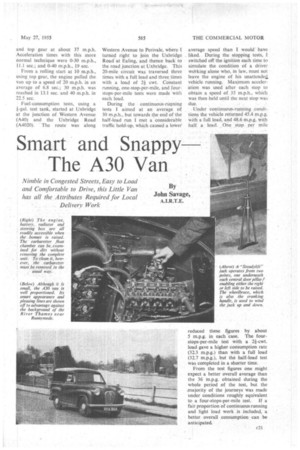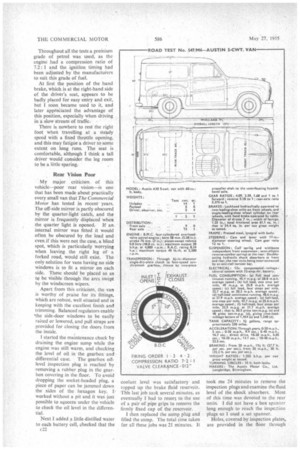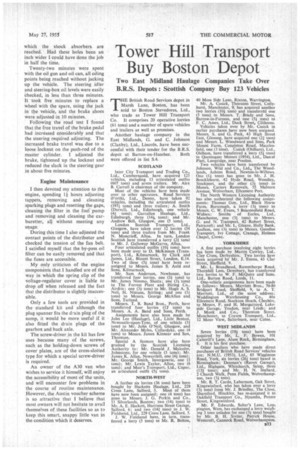Smart and Snappy The A30 Van
Page 61

Page 60

Page 62

Page 65

If you've noticed an error in this article please click here to report it so we can fix it.
Nimble in Congested Streets, Easy to Load and Comfortable to Drive, this Little Van has all the Attributes Required for Local Delivery Work
WHILE the Austin A30 5-cwt. "van was in my possession I covered nearly 600 miles without travelling farther than 30 miles from London. The overall fuelconsumption rate of 36 m.p.g. which was obtained, indicates the return to he expected from this van when it is operated on short journeys in congested areas with a full load and a passenger.
Rapid acceleration from rest, good cornering ability and a small steering lock make for excellent manceuvrability in traffic, and enable high average speeds to be maintained on ihe " back-double " routes often favoured by delivery-van drivers.
The Austin maintenance-voucher scheme can be used to ensure that the van gets regular specialized attention at standard rates, but 1 carried out a few routine maintenance tasks and found that they should present no difficulty for the owner who may wish to service hi own vehicle. The overhead-valve engine, transmission and suspension are of the same design as in the A30 private car, and the allsteel body is of integral construction.
The single, wide-opening door at the rear provides ample access to the 60-cu.-ft.-capacity van body which can also be reached from the driving compartment. A passenger seat is available as an optional extra, and the squabs of both seats fold forward to facilitate loading from the front.
c20 The lively acceleration is partly attributable to the low-geared back axle drive which has a ratio of 5.375: 1, as compared with the 5.125: 1 ratio currently used in the private car. The maximum speed of the van is well over 60 m.p.h. Hyd raulic shock absorbers and the Austin design of independent-front-wheel suspension give a smooth and stable ride at high speed, whether the vehicle be fully laden or empty.
Notable features of the engine are the split-skirt-type aluminium pistons with Alumilite finish, and the forgedsteel camshaft with cams of special design for quiet operation. Holes in the connecting rods provide oil quickly to the cylinder walls when warming up. Petrol is fed to the
Zenith downdraught carburetter by an A.C. mechanical fuel pump.
I collected the van in London and
surprised that I had achieved a braking efficiency of nearly 100 per cent., so I checked the result several times and found that it was accurate and repeatable.
Later, during extensive driving in traffic, I had ample opportunity to confirm that the brakes were extremely efficient, but I attribute the exceptionally short stopping distance obtained during the braking tests to the particularly rough surface of the concrete road.
Acceleration tests were made from rest to 20. 30 and 40 m.p.h. The van reached 20 m.p.h. in 5 sec., • using second gear, 30 m.p.h. in 9.4 sec., also in second gear, and 40 m.p.h. in 16.7 sec. in third gear. In these gears the engine speed was well above that at which maximum power is developed, so I repeated the tests,. changing into third gear at 27 m.p.h. and top gear at about 37 m.p.h. Acceleration times with this more normal technique were 0-30 m.p.h., 11.1 sec.; and 0-40 m.p.h., 19 sec.
From a rolling start at 10 m.p.h., using top gear, the engine pulled the van up to a speed of 20 m.p.h. in an average of 6.8 sec.; 30 m.p.h. was reached in 13.1 sec. and 40 m.p.h. in 22.5 see.
Fuel-consumption tests, using a i-gal. test tank, started at Uxbridge at the junction of Western Avenue (A40) and the Uxbridge Road (A4020). The route was along
Western Avenue to Perivale, where I turned right to join the Uxbridge Road at Ealing, and thence back to the road junction at Uxbridge. This 20-mile circuit was traversed three times with a full load and three times with a load of 2/ cwt. Constant running, one-stop-per-mile, and fourstops-per-mile tests were made with each load.
During the continuous-running tests I aimed at an average of 30 m.p.h., but towards the end of the half-load run I met a considerable traffic hold-up, which caused a lower
average speed than I would have liked. During the stopping tests, I switched off the ignition each time to simulate the condition of a driver wdrking alone who, in law, must not leave the engine of his unattended. vehicle running. Maximum acceleration was used after each stop to obtain a speed of 35 m.p.h., which was then held until the next stop was due.
• Under continuous-running conditions the vehicle returned 45.4 tn,p.g, with a full load, and 48.6 m.p.g. with half a load. One stop per mile reduced these figures by about 5 m.p.g. in each case. The fourstops-per-mile test with a 24-cwt. load gave a higher consumption rate (32.3 m.p.g.) than with a full load (323 m.p.g.), but the half-load test was completed in a shorter time.
From the test figures one might expect a better overall average than the 36 m.p.g. obtained during the whole period of the test, but the .majority of the journeys was made under conditions roughly equivalent to a four-stops-per-mile test. If a fair proportion of continuous running and light load work is included, a better overall consumption can be anticipated. Throughout all the tests a premium grade of petrol was used, as the engine had a compression ratio of 7.2 : 1 and the ignition timing had been adjusted by the manufacturers to suit this grade of fuel.
At first the position of the hand brake, which is at the right-hand side of the driver's seat, appears to be badly placed for easy entry and exit, but I soon became used to it, and later appreCiated the advantage of this position, especially when driving in a slow stream of traffic. •
There is nowhere to rest the right foot when travelling at a steady speed with a fixed throttle opening, and this may fatigue a driver to some extent on long runs. The seat is comfortable, although I think a tall driver would consider the leg room to be a little sparing.
Rear Vision Poor My major criticism of this vehicle-poor rear vision-is one that has been made about practically every small van that The Commercial Motor has tested in recent years. The off-side mirror is partly obscured by the quarter-light catch, and the mirror is frequently displaced when the quarter light is opened. If an internal mirror was fitted it would often be obscured by the load and even if this were not the case, a blind spot, which is particularly worrying when leaving the right leg of a forked road, would still exist. The only solution for vans having no side windows is to fit a mirror on each side. These should be placed so as to be visible through the arcs swept by the windscreen wipers.
Apart from this criticism, the van is worthy of praise for its fittings, which arc robust, well situated and in keeping with the excellent finish and trimming. Balanced regulators enable *the side-door windows to be easily raised or lowered, and pull straps are provided for closing the doors from the inside.
started the maintenance check by draining the engine sump while the engine was still warm, and checking the level of oil in the gearbox and differential case. The gearbox oillevel inspection plug is reached by removing a rubber plug in the gearbox covering in the floor. To avoid dropping the socket-headed plug, a piece of paper can be jammed down the sides of the hexagon key. I• worked without a pit and it was just possible to squeeze under the vehicle to check the oil level in the differential.
Next I added a little distilled water to each battery cell, checked that the
coolant level was satisfactory and topped up the brake fluid reservoir. This last job took several minutes. as eventually I had to resort to the use of a pair of pipe grips to remove the firmly fixed cap of the reservoir.
I then replaced the sump plug and filled the sump. The total time taken for all these jobs was 21 minutes. It.
took me 24 minutes to remove the inspection plugs and examine the fluid level of the shock absorbers. Most of this time was devoted to the rear units. T did not have a box spannerlong enough to reach the inspez;tion plugs so I used a set spanner.
Holes, covered by inspection plates, are provided in the floor through
which the shock absorbers are reached. Had these holes been an inch wider I could have done the job in half the time.
Twenty-two minutes were spent with the oil gun and oil can, all oiling points being reached without jacking up the vehicle. The steering idler and steering-box oil levels were easily Checked, in less than three minutes. It took five minutes to replace a wheel with the spare, using the jack in the vehicle, and the brake shoes were adjusted in 10 minutes.
Following the road test I found that the free travel of the brake pedal had increased considerably and that the steering required adjusting. The increased brake travel was due to a loose locknut on the push-rod of the master cylinder. I adjusted the brake, tightened up the locknut and reduced the slack in the steering gear in about five minutes.
Engine Maintenance I then devoted my attention to the engine, spending II hours adjusting tappets, removing and cleaning sparking plugs and resetting the gaps, cleaning the filter in the fuel pump and removing and cleaning the carburetter, all without meeting any snags.
During this time I also adjusted the contact points of the distributor and checked the tension of the fan belt.
I satisfied myself that the by-pass oil filter can be easily removed and that the fuses are accessible.
My only criticism of the engine components that I handled are of the way in which the spring clip of the voltage-regulator cover is liable to drop off when released and the fact that the distributor is slightly inaccessible.
Only a few tools are provided in the standard kit and although the plug spanner fits the drain plug of the sump, it would be more useful if it also fitted the drain plugs of the gearbox and back axle.
The screw-driver in the kit has few uses because many of the screws, such as the holding-down screws of cover plates, are of the cross-slotted type for which a special screw-driver is required.
An owner of the A30 van who wishes to service it himself, will enjoy the accessibility of most of the units, and will encounter few problems in the course of routine maintenance. However, the Austin voucher scheme is so attractive that I believe that most owners will not hesitate to avail themselves of these facilities so as to keep this smart, snappy little van in the condition which it deserves.








































































































